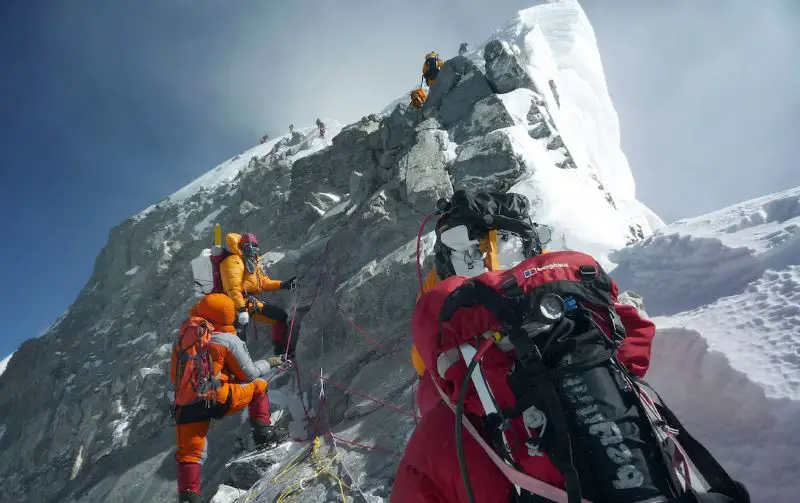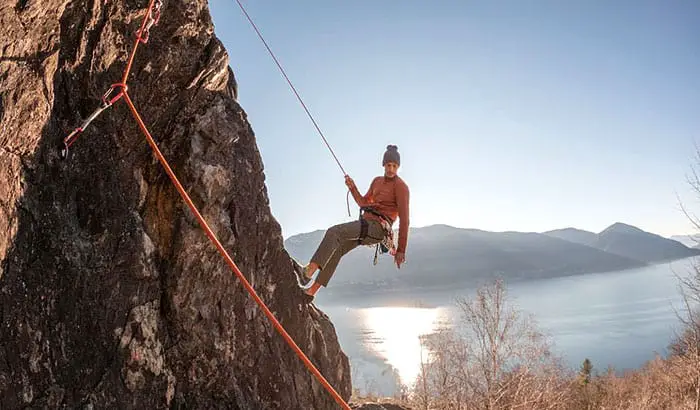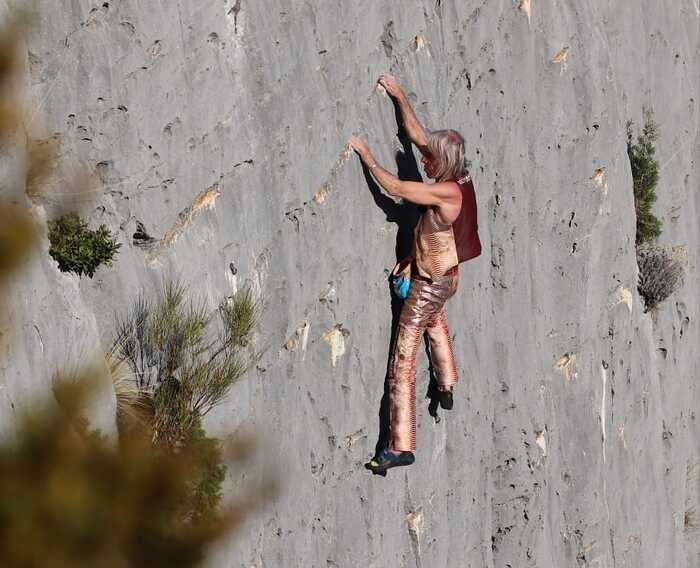Watching the film Free Solo, or any other climbing or mountaineering movie is truly an inspiring experience for many adventurers out there. Unfortunately, the action stops after the climber or the crew reaches the top. After the rolling credits, someone has to have asked the question: How do they get down from there? I certainly have, many times!
Well, there are a few ways in which rock and mountain climbers get down. Usually, they return the same way they climbed there, but what about free solo climbers? They don’t have ropes or any other piece of gear, so what’s the deal with that?
I’ll answer all these burning questions for you below!
How Do Mountain Climbers Get Down
In mountain climbing, in contrast to rock climbing, getting to the top is half the battle. After summiting, they need to head back down the way they came.
Coming back to the base can be done in several ways. Some of them choose to walk down another face through a hiking trail; some prefer lowering; and most of them opt for rappelling.
Most mountaineering accidents happen on the way down, so, like I said, just because you’ve reached the top, doesn’t mean it’’s over. In fact, 56% of deaths on Everest have been on the way down rather than on the summit. Why? Exhaustion, frostbite, avalanche and lack of oxygen.

Marc-Andre Leclerc, one of the best alpinist and free soloist died on the way down from a mountain in Alaska due to an avalanche or rock fall.
If you do find yourself at the top of a mountain, this is how you’d get down.
1) Taking a hike
One of the safest ways to get down a mountain is by just walking off. Usually, this happens in great national parks such as Yosemite, where there’s a hiking trail on the other side. Walking down a route offers an easy descent. Of course, you should always keep in mind that if you have gear placed somewhere, you should retrieve it.
2) Lowering
A popular method for descending in mountain climbing is lowering. Basically, it consists of the belayer lowering the climber, like in a top-rope climb situation. When climbers reach the top, they simply thread the rope through the belay station and get lowered down.
3) Rappelling
When it comes to most forms of climbing (maybe not free solo), the go-to choice for descending is the good ol’ rappel.

Safe, easy, and without putting unnecessary friction on the rope, rappelling, or abseiling (if you are a fan of German terminology), consists of the climber threading the rope through the top anchor while making sure the ends are the same length. To make the rappel, the climber will have to use an ATC, figure eight, or even a carabiner with a rappel knot.
How Do Rock Climbers Get Down
When climbing big faces such as El Capitan, rock climbers walk back to camp using the hiking trails.
Trad climbers usually use the hiking way back or rappel. If there is placed gear in the wall, they’ll use the rappel or lowering technique in order to retrieve the pieces.
Of course, there are situations like when Tommy Caldwell and Kevin Jorgenson climbed the Dawn Wall when they left various objects on their way up, and the camera crew contributed by helping them retrieve these items.

A great question mark is how do climbers retrieve their anchors? I mean, they need them to get down safely, right?
Most of the rock climbing routes in the world are equipped with fixed anchors that stay there. But if a trad anchor is built in order to get down, most of the time the climbers will leave that behind and maybe return some other time to retrieve it.
In some areas, rock climbers can find a tree near the edge of the rock and build a small anchor around it. You might shed a tear leaving expensive gear behind, but that’s just how it goes.
Of course, when you are sport climbing, your belayer will lower you down, which is the safest way to get down as a rock climber.
How Do Free Solo Climbers Get Down
When climbing free solo, you have the advantage of keeping your gear to the minimum, meaning you’ll have just your shoes, chalk bag and a whole lotta balls. Of course, even if you don’t have that many pieces to care about, the logistics still play a major role in making a successful return to camp, because with free solo, if you don’t make it back, something has gone terribly wrong.
Knowing how to get down is just as important as knowing how to get to the top (to avoid the inevitable death), and there are some rather creative ways free solo climbers choose to return to the base.
1) Walking Off
Of course, taking the hiking trail back home is the most sought after method when finishing a free solo climb. A nice and relaxing walk into the sunset is just the perfect way to end a glorious day on the wall (followed by some celebratory beers, of course).

For hiking down, the climber will need to have on him or place somewhere on the top a pair of hiking shoes because walking in climbing shoes is not only a pain, but it will ruin them. Of course, there’s always the barefoot method, but let’s face it, unless you are Alex Honnold walking barefoot down the trail after casually free soloing Half Dome, how many people can take it?
2) Down Climbing
I like to call this the Alain Robert method because I’ve seen him do it more than other free solo climbers, although I bet most of them had to do it at least once.
There are situations where there is no top-out on a route and the climber has to get down somehow without calling mountain rescue. Down climbing is basically coming down the same way you got up.

At first sight, it sounds easy peasy, but it’s in fact not such a walk in the park for multiple reasons. First is the inability to see the proper foot holds because, when down climbing, you can’t really see what comes next compared to seeing the wall from the bottom to the top.
Second, when rock climbing, there are certain holds that will feel safe in only one specific position, so the risk of slipping is increased due to the “altered” position we have while down climbing.
Definitely not my preferred method of getting down anyway.
3) FreeBASE
BASE jumping, first pioneered by Carl Boenish is a sport in its excellence that requires jumping from a fixed object, such as a high tower, rock, or platform, using a parachute to get you safely back on the ground. BASE is actually an acronym that defines where you can jump from buildings, antennae, spans (bridges), and earth (cliffs).
Combining BASE jumping and free solo, Dean Potter, the illustrious Yosemite Stone Monkey, popularized the method of freeBASE.

When Dean first integrated his parachute into climbing, it was a safety net when he began pushing his solo climbs. A parachute can provide a layer of safety, but it does have a few variables, such as the height you climb and how you jump off the wall. And of course, you need training to be able to know how to use a parachute.
This isn’t a preferred method, and there is some discrepancies on how much Dean Potter actually used this method to get down from free solos, so I wouldn’t go jumping off the side of cliffs.
Worth a mention though!
4) Descending on rope
There is always the method of descending using a rope, but this kind of beats the purpose of free solo climbing as you’ll have to haul your gear up the wall. Nevertheless, this is a method many free soloist use. Brette Harrington, when she free soloed Chiaro di Luna, carried her rope up with her and rappelled down.

In order to rappel down the wall, you’ll require, of course, the rope, a belay device, and, depending on the place where you are, even some extra gear to build an anchor.
It’s not such a practical idea as it increases the risk of making a mistake. Climbing the wall might even be harder because of the increased weight you are carrying, and it’s not very comfortable either.
What Happens When Things Go Wrong While Free Soloing?
Unfortunately, when things go wrong while free soloing, the chances of making out alive are slim. There are situations where free solo climbers simply get stuck on the wall, are too tired to continue, can’t find their next move, or even get lost on big walls.
Usually, finding a ledge or a comfortable position is the first step a climber takes in order to rest and recollect.
Now, the options are pretty limited. One of them is calling for help if you have phone reception or people around. The other options don’t seem so fun and safe.
Down climbing is a method worth trying, but only if the moves are safe and certain, although there are situations where you can get stuck on the wall with no way up, down, left, or right.
The most popular method is, after taking time to recollect, just pushing higher to the end of the route because free solo climbers should always make their homework very thorough and leave little or no room for error.
Reading the wall, knowing your route, and taking on a grade you are very comfortable with are essential when free solo climbing.



